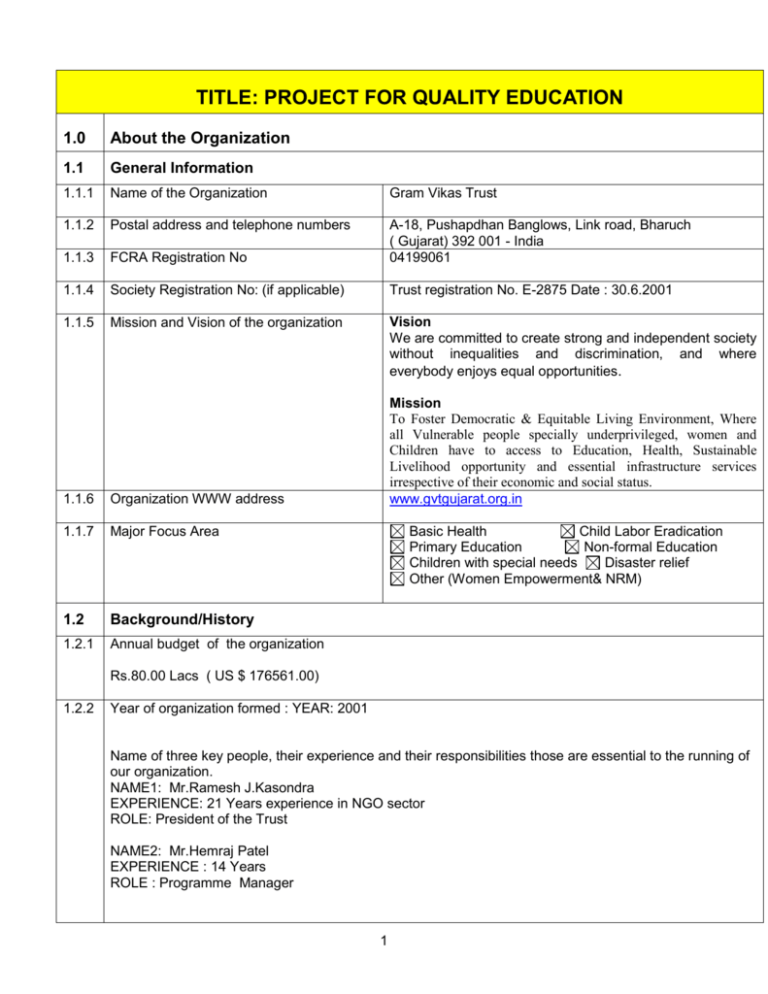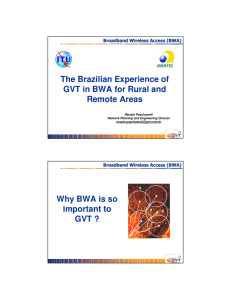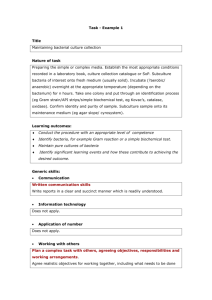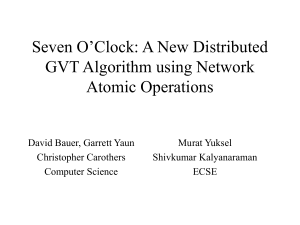This project has provided additional documentation in a Microsoft
advertisement

TITLE: PROJECT FOR QUALITY EDUCATION 1.0 About the Organization 1.1 General Information 1.1.1 Name of the Organization Gram Vikas Trust 1.1.2 Postal address and telephone numbers 1.1.3 FCRA Registration No A-18, Pushapdhan Banglows, Link road, Bharuch ( Gujarat) 392 001 - India 04199061 1.1.4 Society Registration No: (if applicable) Trust registration No. E-2875 Date : 30.6.2001 1.1.5 Mission and Vision of the organization Vision We are committed to create strong and independent society without inequalities and discrimination, and where everybody enjoys equal opportunities. 1.1.6 Organization WWW address 1.1.7 Major Focus Area 1.2 Background/History 1.2.1 Annual budget of the organization Mission To Foster Democratic & Equitable Living Environment, Where all Vulnerable people specially underprivileged, women and Children have to access to Education, Health, Sustainable Livelihood opportunity and essential infrastructure services irrespective of their economic and social status. www.gvtgujarat.org.in Basic Health Child Labor Eradication Primary Education Non-formal Education Children with special needs Disaster relief Other (Women Empowerment& NRM) Rs.80.00 Lacs ( US $ 176561.00) 1.2.2 Year of organization formed : YEAR: 2001 Name of three key people, their experience and their responsibilities those are essential to the running of our organization. NAME1: Mr.Ramesh J.Kasondra EXPERIENCE: 21 Years experience in NGO sector ROLE: President of the Trust NAME2: Mr.Hemraj Patel EXPERIENCE : 14 Years ROLE : Programme Manager 1 1.2.3 Reference of three groups that have funded us in the past. GROUP 1: Asha for Education Dollas & CNJ Chapter. GROUP2: Save The Children GROUP3: Vibha 2.0 About the Project 2.1 General Information 2.1.1 Title of the project. A brief description of project Send An Indian Child to School for a year (The project to improve enrollment, retention and quality of education in 50 primary schools). Gram Vikas Trust in Bharuch has been focusing on the strategy of Education for All. However, it has realized and experienced that this approach is not sufficient for bringing all children to school. Gram Vikas believes that all children who are out of school are engaged in some sort of labor. Hence they should be identified and supported to be in education system. Specifically, the following points make it clear why Gram Vikas Trust has made a shift in its focus. 1. “Secondary Education for All” is not covering all eligible school-going children because there is no secondary schools in most of the villages as well as there is no quality education in primary schools. The current approach does not address the issue of out-of-school children. Through Sikshana model, the schools are likely to be attractive enough for such children and their parents. 2. If the education system becomes a happening place for such children, they are likely to continue their education to secondary level and that will automatically reduce / eliminate child labor problem. There should be consensus among all stakeholders about the harms child labour does to the family, society and the nation. 3.By implementing this successful model, we aim to achieve the ultimate aim of “Education for All” The current scenario of learning level of primary school children is as given below. These findings are based on the formal survey done by GTV in 120 primary & secondary government schools. 1. Children from Classes II to V were tested in reading paragraphs with short sentences and long sentences, subtraction and division. 35% of all children in the agegroup 7-14 could not read simple paragraphs at the Standard I level, and close to 52% could not read a short story at the Standard II level of difficulty 2 2. 40% of children who are in school and studying in Standard V could not read the story text at the Standard II level of difficulty. 3. Although many more children in higher classes (Standards VI to VIII) can read. 4. However, the performance differs from school to school. For example, in Rahiyad, Galenda and Samatpor less than 25% of children currently studying in Standard V were able to read a story of Standard II level with ease. In general, the proportion of children unable to read at this level is substantially higher in several other schools -- close to 50% of children cannot read a simple 'story' text of Standard II level. 5. 50% of Standard II to Standard V children in proposed government primary schools could not solve a two-digit subtraction problem. 6. In higher classes (Standards VI to VIII), 40% of proposed government school children could not solve a simple division problem (three digits divided by one digit). As with reading, there are significant school wise variations in arithmetic learning too. For example, based on the sample of children in Standard V – some schools over 50% of children can do simple division problems. In some schools, 62% to 75% of Standard V children cannot solve division problems (three digits divided by one digit). 2.1.2 Vision and Mission of Project To improve the quality of education in primary schools, so the children develop interest in continuing secondary education and make Secondary Education accessible to all the eligible children. 2.1.3 Name of contact person Mr.Ramesh J.Kasondra 2.1.4 Address of contact person Email/ Phone/ Address 2.1.5 Target Community details A-18, Pushapdhan banglows, Link road, Nr.HDFC Bank, Bharuch (Gujarat) –392001 India gvt_trust@yahoo.co.in The General background information of the project area are: Education: Project villages have among the lowest rural literacy rates. Illiteracy rates are also reflected in among the lowest enrolment and highest dropout rates of students in the area. Health : Reproductive & Child health care facilities in this area 3 are inadequate as both the infrastructure and qualified lady doctor are not available in PHC. As a result of more than 67% women do not get medical attendance during pregnancy and child birth. About 85% deliveries are conducted at home only with the help of untrained birth attendant. This results in death of one female in every 37 pregnancy and child birth. Since 58% children do not receive vaccination, the infant mortality rate is also very high. Land: Land resource are also facing major problem due to salinity increase. The entire block is rain fed area. Groundwater: Ground water resources in the area have depleted to critical levels, resulting in the inability of farmers to withstand drought, and saline water deteriorating quality of drinking water causing immense burden for women. There is no drinking water source in the villages of project area except Gujarat water supply board scheme. Industrialization: The Bharuch is know as developing industrial area especially along the coast line and that is increasingly eating into natural resources and degrading them, impacting negatively on the local population who depend on these resources. As a result, the distressed rural population is migrating destroying their social fabric, and perpetuating illiteracy among the poor. 2.1.5 Number of children impacted a. Direct impact through program b. Indirect impact through program 7850 Children ( 50 Primary Schools) 62520 Population 4 2.2 Project Activity Plan. LIST Activities that take place as a part of the project plan, their duration, and the frequency For eg. 2.3 Activity Duration Frequency No. of children/ community Resource person responsible Meeting with the teachers for orientation of the project and project objective. 1 day Initially School principal GVT Staff School assessment 1st month Once in a year 16 schools Project manager & team of GVT Teachers training on Goal Setting Two days Once in a year All teachers GVT staff Heightened social awareness 1 day Once in QTR Village Community GVT Steff & Teachers Parent Teacher Association Mtg. 1 day Once in Month Parents + Teachers GVT Staff Village Education Committee Mtg. 1 day Once in Month VEC Members School Principal + GVT Writing Activities for each children of V & VII Std Through out the year Weekly Children of V & VII std. Class teachers + Mentor Library Through out the year One book in a week Children of each class Class teachers + Mentor School Competition 1 day Once in QTR All children School Principal + Mentor Educational Tour 1 day Once in a year All Children School Principal + Mentor Project Evaluation and Documentation: Gram Vikas Trust staffs will regularly carry out monitoring of the project activities. However, every effort will be made to involve concerned line agency staffs, and community groups in the monitoring process. The capacity of the school committee will be built for monitoring purpose. Gram Vikas Trust will conduct program review meetings on half yearly basis. In all planning, review and evaluation activities all stakeholders will participate. Quarterly reports will be made and submitted for information and comments. EMIS will be established at the district and school levels and its proper use for planning and monitoring of this project will be ensured. Under this system each child will be monitored and efforts will be made to reach all non-school going children. Head counting will be done three times a month by a stakeholder, Gram Vikas Trust staff and teacher to improve regular attendance of school going children. An independent evaluation (mid term and final) will be conducted towards middle and the end of the project respectively. The findings and recommendations of mid-term evaluation will be used in the planning and implementation of the project in the remaining period of the project. 2.3.1 Goals ( List goals of the project – and state if it will be measured qualitatively or quantitatively) 5 The Goal of the project are : 1. 2. 3. 4. 5. 6. 7. 8. 7850 children of 50 primary schools will equipped with quality education so that they achieve expected learning levels. Motivate the teachers for ownership among them for the quality education to all children. Each school will have its well defined goal for the next year goal and every year upgrade one point in terms of quality education. Organize school competitions on sports, quiz etc on regular basis. To promote the education among the socially backward people of the village. Regularize and strengthen VEC and PTA meetings to develop ownership among them. Create “Ram Shop” in each school to built integrity among the children. Reduce the drop out rate in higher education through quality education. The qualitative Indicators would be: 1. 2. 3. 4. 5. 6. 7. 8. Increased motivation level of children and teachers to do their best. Increased awareness level of parents to educate their children. Increased positive energy level in school environment Increased ownership level of teachers, head masters, VEC,local government institutes etc… Increased positive public image of the government in eye of general public of villages Overall change in attitude of government officials at block & district level Increased learning level & coping capacity of children. Increased interest level among children to continue their education in secondary schools The quantitative Indicators would be: 1. 2. 3. 4. 5. 6. 7. 8. Reduced drop- out rate in these schools Increase in school enrollment Increase in school attendance Increase in number of non-academic activities in schools Increase in number of parents & members of school and village education committee Measured performance level of each child through - APF tool Increased number of children joining secondary schools Reduced number of child labor in these villages 2.4 Project Budget 2.4.1 Total Project Cost Item wise budget Description of Expenses per School Mandatory Writing Sheets Library Competitions Scholarships Spot Prizes Teacher Training Exams / Assessments 6 Unit Cost in Rs. Per School % distri. 26500 3000 4400 2500 3600 2500 5000 3000 5.00% 7.33% 4.17% 6.00% 4.17% 8.33% 5.00% Ram Shop ( Stationary item) Non-formal education centre (Kidagan) Educational Tours Para Teachers Sports / Music Teaching Aid 2500 4.17% 18500 4000 8000 3000 3500 School Defined Initiative 6.67% 13.33% 5.00% 5.83% * School Fund Mentoring & Monitoring Admin 45000 12000 3000 Total 60000 100.00% Grand Total for 50 Schools Rs. 30,00,000 In US $ 66210.55 75.00% 20.00% 5.00% * In lieu of the optional items the school is free to discuss with GVTstaff and decide on the best way to utilize the funds to achieve its goals The cost per child would be Rs.382.16 per year ( IN US $ 8.43) 2.4.2 2.4.3 3.0 Amount selffinanced/already available Funds requested from Vibha Rs.Nil Rs.30,00,000/- In US $ 66210.55 Reference Reference 1 Mr.Arvind Iyer Project Coordinator ( Asha for Education – CNJ) Asha for Education (Central New Jersey) 1308 Centennial Ave Suite 117 Piscataway, NJ 08854 Email : ayyer@physics.rutgers.edu Phone: 732-878-9319 7 Reference 2 Rajan Mohanty State Program Manager Save the Children |INDIA| Gujarat Office Landline: +91 79 26937669 | Mobile: 09687600590| 22, Nest Bungalow, Near Visat Nagar, Ramdevnagar- Anandnagar Road, Satellite, Ahmedabad-380015











